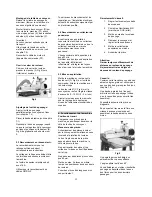
8
Grit 80:
Surfacing, light dimensioning, most
popular grade.
Grits 100 and 120:
Surfacing and finishing.
Grits 150, 180 and 220:
Finish sanding only.
7.3 Cleaning drum abrasives
Regularly clean the abrasive strips on
the drum with the supplied cleaning
stick.
This will remove the deposits and help
extend sandpaper life.
Warning:
Always wear tight fitting clothes
and eye protection. Keep alert
during this operation to avoid
injury.
Operate the sanding drum with the
oszillation turned off and with the dust
cover open.
Hold the cleaning stick (Fig 13)
against the rotating drum and move it
along the drum surface.
It is good procedure to use a shop
brush to remove any cleaning stick
crumbs before resuming sanding
operation.
Fig 13
Abrasive life can also be increased by
reversing the trailing and starting end
of the strip.
This will provide a fresh set of cutting
edges on the abrasive.
7.4 Oscillaton
The 22-44OSC sander can be
operated as a simple linear sander or
as an oscillating sander.
Before changing the sanding
operation, the sander must be turned
off.
Linear Sanding:
Before changing the sanding
operation, the sander must be turned
off.
For linear sanding mode, pull out the
oscillator switch (A, Fig 14).
Fig 14
Oscillating Sanding:
Before changing the sanding
operation, the sander must be turned
off.
For oscillating sanding, push in the
oscillator switch (A, Fig 14).
Rotate the oscillator switch until the
clutch (B, C) engages.
Operating Note:
For best results, the feed rate must be
set to maximum when in the
oscillation mode.
7.5 Drum alignment
Disconnect the machine from the
power source (pull mains plug).
Remove the abrasive strip from the
drum and use a straight edge or ruler
(Fig 15) as a thickness gauge.
Fig 15
Insert the gauge between the drum
and the conveyor bed and inspect for
parallel contact.
To align the drum, loosen the four hex
bolts (R and S, Fig 16).
This allows the entire drum carriage to
pivot on two bolts (R).
Fig 16
Align the drum by turning the fine tune
adjustment knob (T).
When drum is parallel tighten the four
hex bolts.
Fine tuning drum alignment:
For optimum sanding of boards wider
than the drum, the drum alignment is
critical and must be exactly level to
slightly high on the outboard end.
Turn the board and without changing
the drum height, sand the other end of
the board. If a ridge is visible due to
drum overlap, loosen the four hex
bolts (R+S, Fig 16) and raise the
outboard end of the drum by turning
the fine adjustment knob (T) slightly
clockwise and tighten the four hex
bolts.
Important:
Only turn the fine tune adjustment
knob (T, Fig 16) when all four hex
bolts (R and S) are loose.
7.6 Conveyor belt adjustment
To align the tension of the conveyor
belt, first adjust the take-up screw nut
(U, Fig 16) on both sides of the
conveyor to obtain approximately
equal tension.







































